Story by Rick Hynum | Photos by Keith Perks, 1120 Studios
Cities like Philadelphia and Pittsburgh get all the glory. But if you want to explore the real Pennsylvania, look to the northeast: the ski slopes of the Poconos, Triple-A baseball in Scranton/Wilkes-Barre, the Houdini Museum, anthracite coal out the wazoo, not to mention some of the best pizza in the USA. And for the latter, let Jim Mirabelli and his website, NEPA Pizza Review, be your guide.
Mirabelli will deny it—the man is exceedingly modest—but he’s pizza royalty in northeastern Pennsylvania, an influencer who can transform a restaurant’s business with a single review. And it’s hard to imagine that anyone knows more about the region’s pizza than he does. Remember that episode of The Office when Michael Scott orders from Pizza by Alfredo and Kevin compares the pie to a “hot circle of garbage”? Mirabelli would never make that mistake. If Pizza by Alfredo existed (which it doesn’t), he would have already tried it. And if Alfredo’s Pizza Café—recommended by most of the Dunder-Mifflin crew—existed, Mirabelli would have already reviewed it for his tens of thousands of followers.
Related: Jim Mirabelli Q&A: Exploring the pizza-crazy NEPA region
And his review would be incisive and detailed—none of that one-bite stuff for him. If the pizza’s good, Mirabelli tells you what makes it good, from the frico edge to the tang or sweetness of the sauce. And if the pizza’s not good, well, he simply won’t review it. As the pizza industry’s goodwill ambassador of northeastern Pennsylvania, Mirabelli follows the old adage, “If you can’t say something nice, don’t say anything at all.”
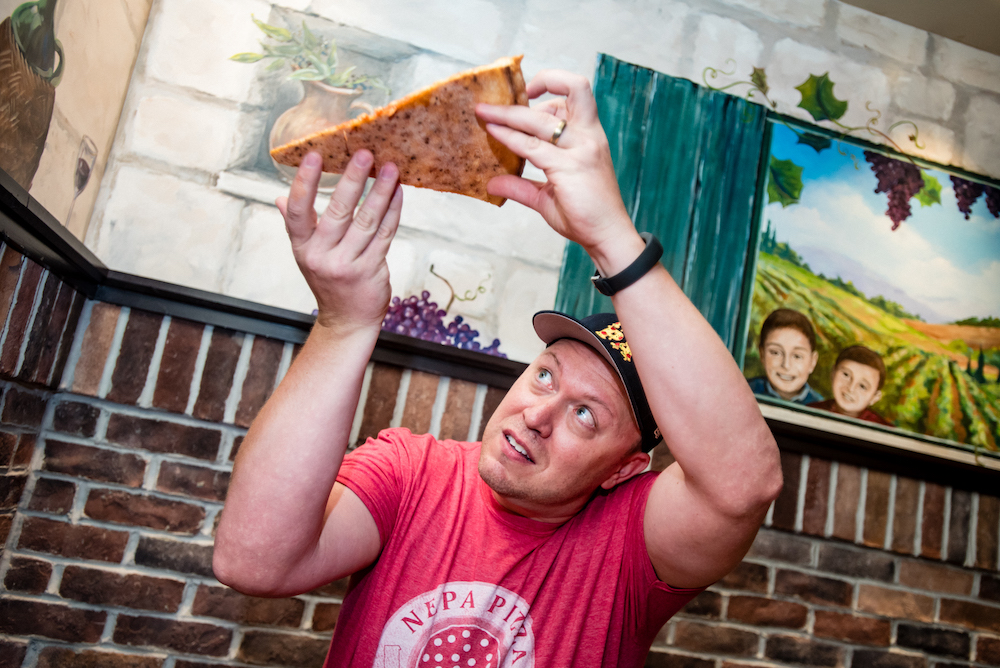
Mirabelli rates pizzas based on crust, sauce, cheese, flavor, bake and value.
The Accidental Influencer
Mirabelli didn’t set out to be a pizza influencer. He has a degree in accounting and an MBA, serving as the business administrator at Abington Heights School District in Clarks Summit. But throughout high school and college, Mirabelli toiled at pizza shops, washing dishes at first, then tossing dough and making pies. But “toiled” isn’t quite the right term. He loved the work.
“I’ll just never forget how they treated me,” he reflects, fondly. “They never treated me like anything other than one of them. And they showed me everything I needed to know….We’re in the trenches together, and it’s just this love of the battle—Friday nights where you batten down the hatches and just churn out pizza. It was an amazing time with great camaraderie…and making people happy. I always treated every pizza I made as if I was making it for the president of the United States.”
Mirabelli loves his day job, too, and he always felt torn between pizza and number-crunching. The numbers won out, but when his former co-workers at Dino and Francesco’s in Clarks Summit needed help, Mirabelli happily filled in. Then, in 2012, he founded NEPA Pizza Review, a blog that started out as a graduate school project. “It connected with me, so I turned in that assignment, but the urge to keep creating remained,” he recalls. “I never intended for anyone to read it. I didn’t have a goal other than to express myself creatively. I didn’t even tell my family or friends I was doing it.”
Related: Who are the country’s leading pizza influencers for 2023?
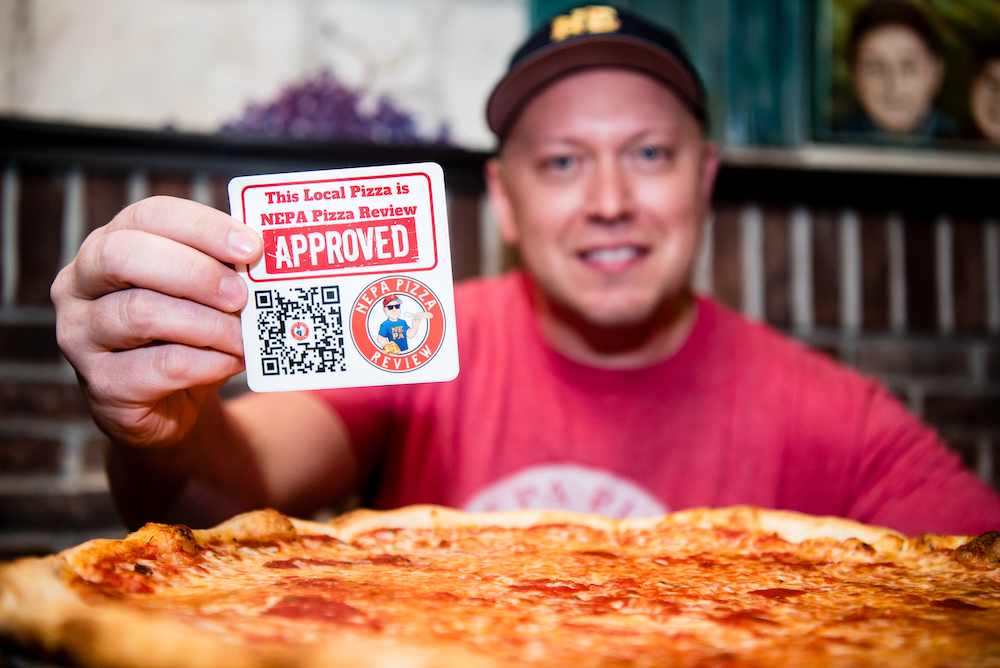
A positive review from Mirabelli can transform a pizzeria’s business.
But the secret got out after Mirabelli gave a five-star review to a pizza shop and then heard from a buddy who was trying the place out. “He called me up and said, ‘Hey, man, I was just waiting in line at this pizza place, and the lady in front of me said there’s a guy who writes about pizza and he gave it five stars and that’s why she’s here to try it. You like pizza. You should check out the site.’ And I said, ‘Well, that’s me.’ That was a cool moment where I said, ‘Oh, people are actually reading this thing.’ And to know I could send just one person to check out this pizza place was profound to me. It was just bizarre, because I never set out to do that.”
For nearly 10 years, though, Mirabelli still treated his blog as a hobby. “Early on, if I got seven clicks in a month, I was, like, ‘Whoa, somebody might have looked at that!’ But I always assumed it was a bot crawling my site. Today, I average about 10,000 unique visitors a month. So not bad. Not great, but not bad.”
But when his dad—a hard-working family man and truck driver—passed away last Christmas, Mirabelli’s mindset shifted. “My dad would do anything for anybody,” he says. “You needed help with something, he was right there for you. He worked himself to the bone and sacrificed to make our lives better. So [NEPA Pizza Review] turned into a tribute to him and became a legacy project to build something that’s not just for me. I’m here to impact other folks’ lives in the way that my dad impacted ours.”
Related: Compare and contrast: Old Forge pizza vs. pan-fried Sicilian pizza
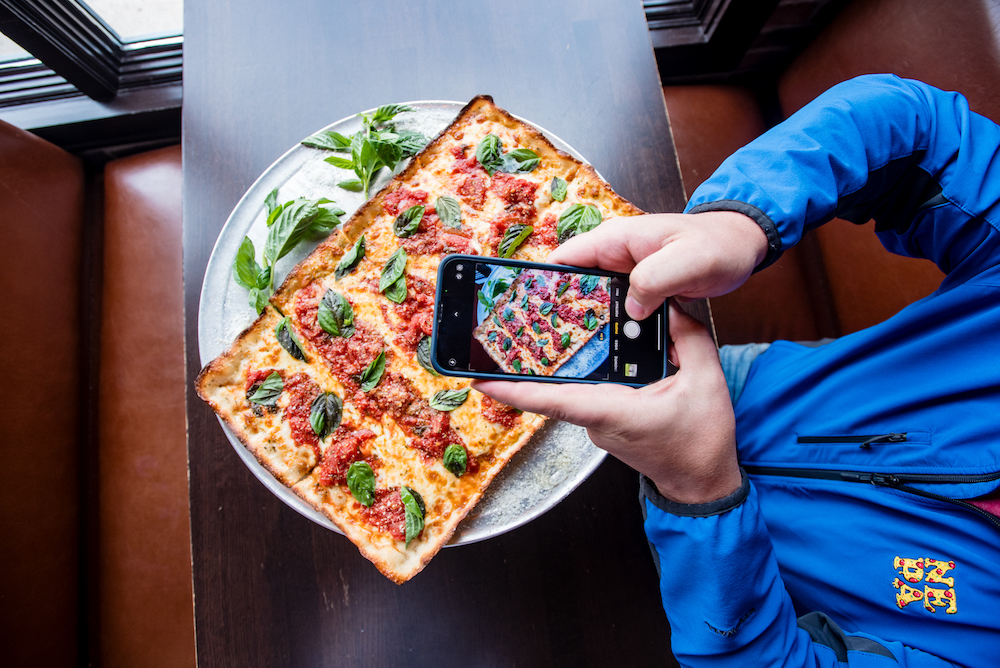
“I can vividly recall every pizza I’ve eaten in the past 10 years,” Mirabelli says.
More Than Money
Like his dad, Mirabelli is a family man. First and foremost, he sees himself as a husband to his wife, Jaimie, and father to his daughter, Layla, and his son, Jack, soon to be 16 and 5, respectively. The kids have appeared in Mirabelli’s social media videos—Layla, in fact, is a natural in front of the camera. Mirabelli doesn’t feel quite so comfortable. “I don’t enjoy making videos,” he says. “I really don’t. But I know that’s the way to tell a story.”
And storytelling is what Mirabelli is all about. When he visits a pizzeria, he wants to know how they make their pizza—and, just as importantly, why. He doesn’t charge them a dime to review their shops. He pays for the pizza himself. He’s not in it for the money. But pizzeria owners need to make money, and, as an influencer, Mirabelli can help.
“I used to take a month off every year, usually in June or July,” he says. “But this year, instead of taking a month off, I ate a dozen different pizzas at different pizzerias. But I’m feeling a real impact. I’m hearing back from these pizzerias. One recently told me his pizza sales have doubled over the last two weeks after my review. And that just drives me to go find another great pizza and share it with people and keep getting those stories out there.”
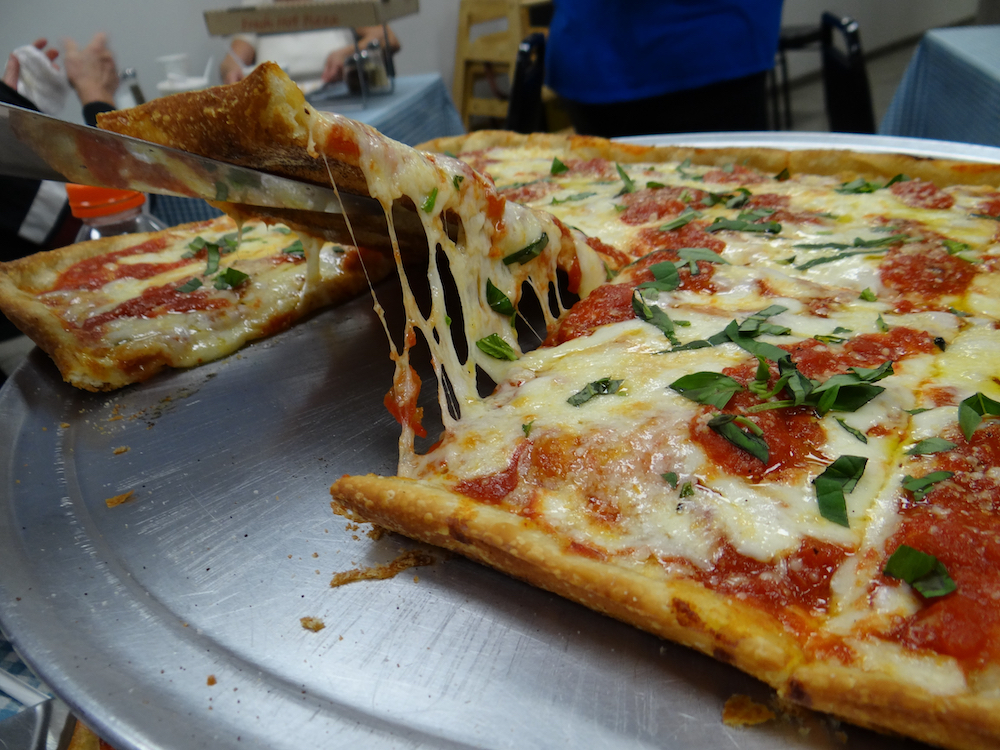
Mirabelli reviewed the pies from Armenti’s Pizza in Olyphant, Pennsylvania, in 2013. (Photo by Jim Mirabelli)
A Customer’s Perspective
Mirabelli can teach pizzeria operators a thing or two as well. For starters, it’s mostly pizza lovers who follow him online. “I tell the restaurant owners: Read my threads, read the comments. It’s free pizza intel about what customers want. You don’t have to pay for it. If you could learn what 100 customers want you to do, it’s right there.”
But he’s also a pizzeria customer who dines out a lot. He sees what operators are doing right and what they’re doing wrong. So what’s his advice for you?
- Think digitally. “We need to start looking at our digital storefront as being more important than our physical storefront. Your social media presence, your website, your Google listing, your Yelp—all of those need to stay updated. You invest so much in signage, in your dining room, in your people, and you should do that. But you are losing so many customers [without a strong digital presence]. There are so many places in my area that do not have a menu posted at all or, at least, not one from the past five years….People want to see your menu on Facebook. Literally, it takes 30 seconds. Take your menu off the holder, set it on the counter, take a picture of it, and hit post. That’s not the best way to do it, but it doesn’t cost you anything.”
- Think carefully about your social media posts. “If your only Facebook or Instagram photos are your daily specials, you’ve got yourself a problem. What are you known for? There’s no worse way to tell a story than to say, ‘I am Jim’s Pizzeria, I sell pizza, but here’s a photo of an omelet that I’m only going to sell one time in the existence of my menu.’ It’s more important to ask yourself, “What do I do best? What’s the long story?’ That’s what people are looking for online. When you see a post that gets one like or zero likes, it’s because it’s not engaging. It doesn’t tell any story. You’re just asking people to buy something. Tell them the story.”
- Don’t just post pretty pictures. “You also need to share the story behind the photo, and you don’t have to be a literary genius. Tell us where the recipe came from. How many versions did it take to get it right? What staff member inspired it? Did a customer ask for it? The next time that customer comes in, give that person the pizza for free in exchange for letting you post a photo of them holding the pizza. Give us a little bio of the customer. He’s going to share it with his friends, because that’s pretty cool. Everybody wins.”
- Tell your own story, too. “But you’ve got to be authentic. People can sniff out a fake a mile away. And if you’re not going to be authentic, you’d better be entertaining. But pizzeria owners are best just being themselves and telling their own real story. If you don’t know what your story is, listen to what your customers are telling you. If you’ve run a pizza shop for 20 years and you don’t know what your story is, you might not be listening to your customers enough. What does your pizzeria mean to people? Does the Little League team eat there after every game? Are you big into the church community? Did your dad teach you how to make the pizza? Did you immigrate here? You have something unique that you’re doing. You’ve done something interesting. You just have to tell me what it is. Or else find something interesting to do and tell people about it.”
- Invest in a good light source. “I use a Lume Cube. It doesn’t make your pizzas look better, but it makes the pizza look like it actually looks. So many pizzerias have these yellow halogen lights overhead. Everything in the photos looks flat and gross. Show them what your pizza actually looks like, not what it looks like under the worst possible lighting conditions. You can pick up a tiny light the size of a wallet for 50 bucks, and you can tune in the brightness and the color and make it look like your pizza actually looks.”
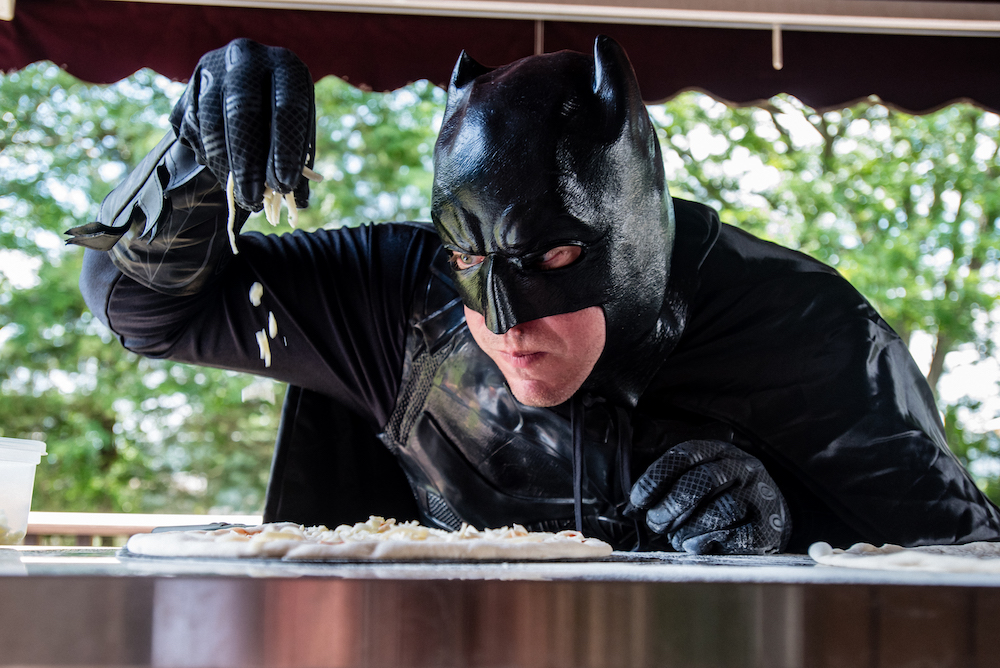
Angling for a partnership, Mirabelli caught Gozney’s attention by donning a Batman costume in a video.
Find a Hook
Although Mirabelli sometimes reviews pizzerias outside of the NEPA region, he doesn’t travel for his blog. “That feels like work to me,” he says. So unless your pizzeria is located in Lackawanna or Luzerne Counties, chances are slim that he’ll review your pizza. But there are other influencers like him around the country. They’re just looking for a hook.
“The best way to get [an influencer] to come to your restaurant is not just ask us to come, but to create something special that makes us want to come—and it should also be something that creates excitement with your customers, so that they will tell us to come,” he says.
Some influencers charge a fee, and that’s OK. They have their own expenses, and it takes time and work to craft a strong, engaging video. “They provide a specific service,” Mirabelli says. “They come in and film and shoot photos, edit the video, feature it on their page. It’s more important to be on their page, because they’re big and they have the eyeballs, but they’ll also give you all the content. It’s like hiring a photographer on the cheap; you get to keep it and you have, like, two months’ worth of content to send out.”
But, for his part, Mirabelli is just happy to help promote great pizza restaurants in his neck of the woods. NEPA Pizza Review is a labor of love, not a moneymaker. He does it for all those pizzerias he cares about and for all those people who care about pizza. “That’s what I’m here for,” he says. “I’m giving back to the people that have given to me. People get into influencer roles for all sorts of reasons. I didn’t ask for it. I didn’t desire to be an influencer, but here I am. So now I take it very seriously.”
Rick Hynum is PMQ’s editor in chief.













